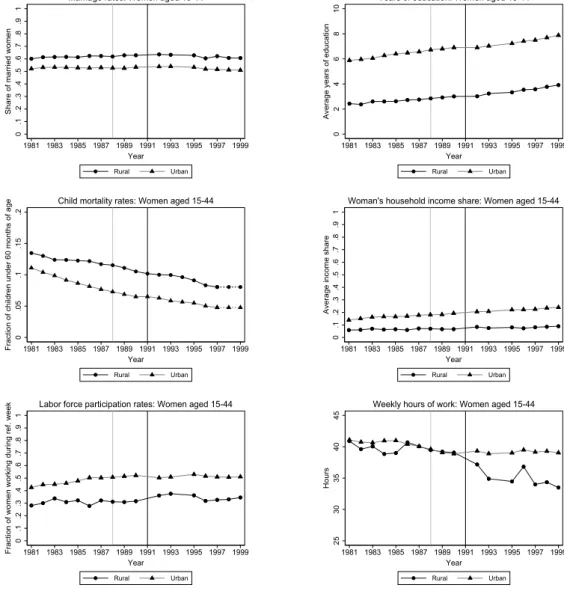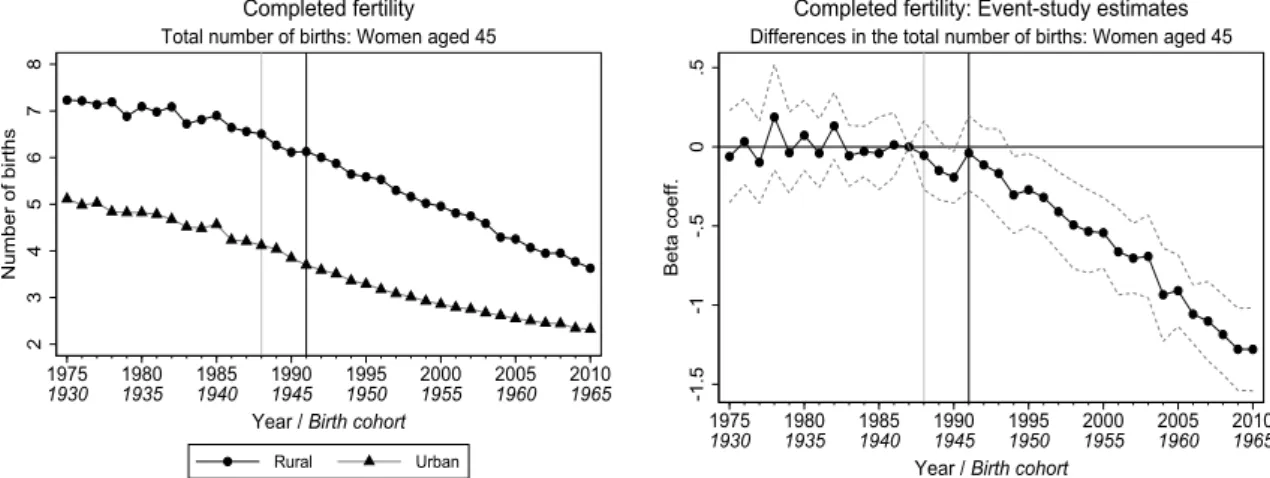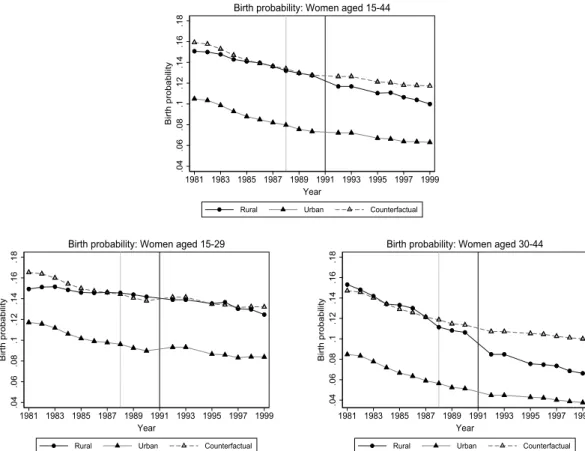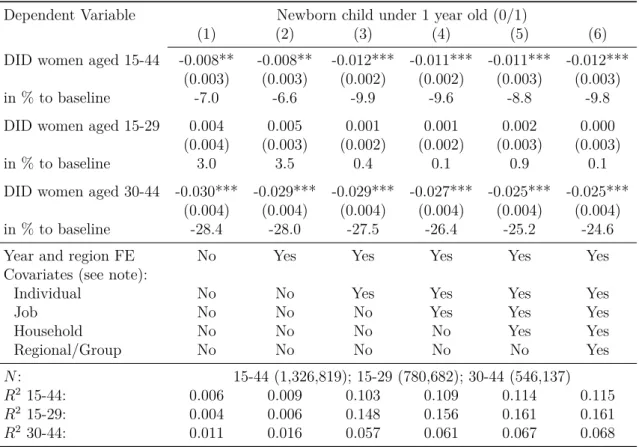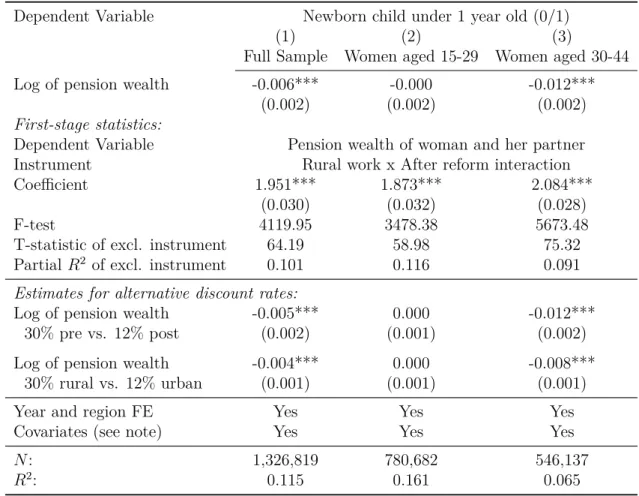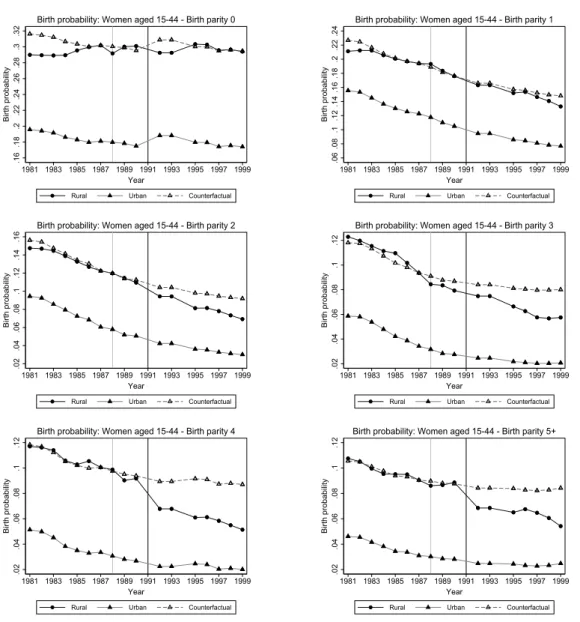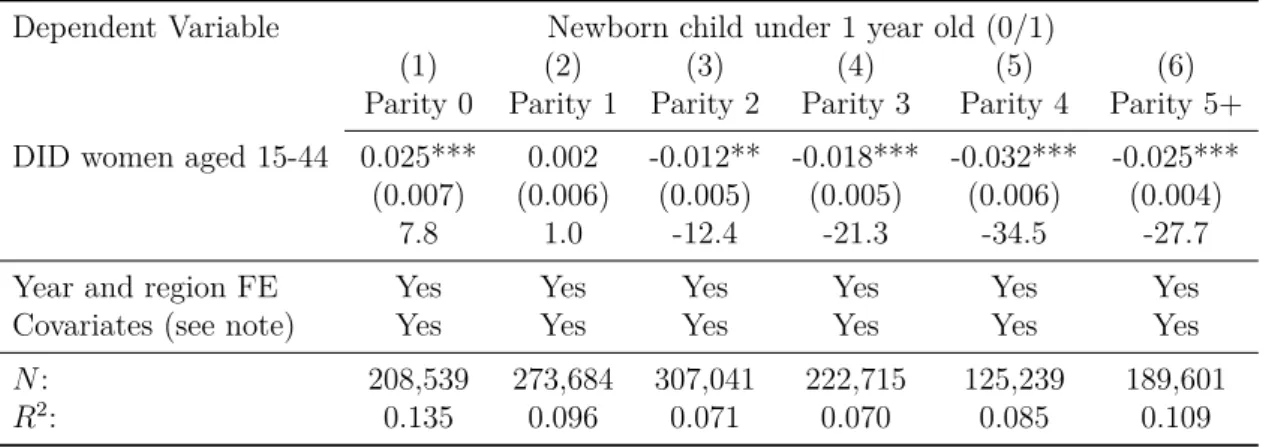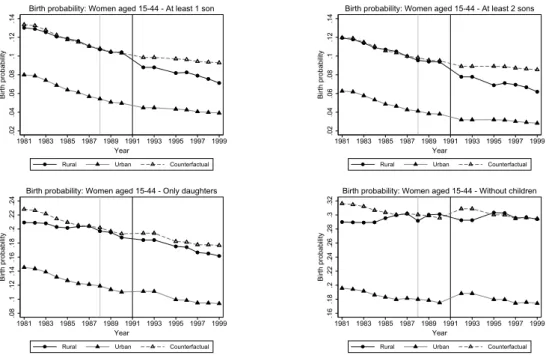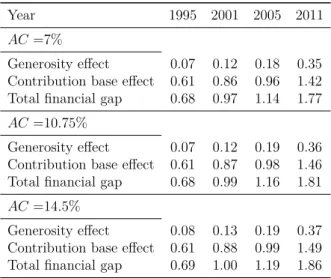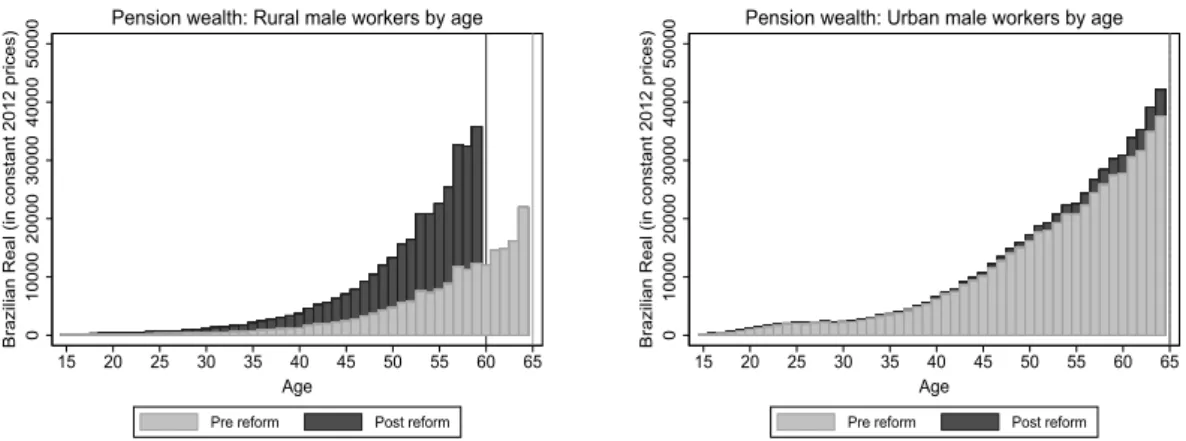Pensions and Fertility:
Micro-Economic Evidence
*Alexander M. Danzer
Lennard Zyska
◦This version: March 2020.
Abstract. This study identifies the causal effect of pension generosity on women’s fertility behavior. It capitalizes on Brazil’s expansion of the pension system to ru- ral workers, whose pension wealth subsequently more than tripled. Event study, difference-in-differences and instrumental variable methods show that the pension re- form reduces the propensity of childbearing of women in fertile age by 10% in the short-run. Completed fertility declines by 1.3 children within 20 years after the re- form, reducing the contribution base of the Pay-As-You-Go pension system in the long-run. The fertility response is strongest at higher birth parities, among older women and among mothers with sons.
Keywords. Pension wealth, Fertility, Old-age security hypothesis, Quasi-experiment, PAYG, Brazil
JEL codes. J13, I38, H55, D15
* The authors are grateful for valuable comments and suggestions by Ot´avio Bartalotti, Vojtˆech Bartoˆs, Michele Battisti, Stefan Bauernschuster, Natalia Danzer, Cormac O’Dea, Philipp D¨orrenberg, Aixa Garc´ıa-Ramos, Ulrich Glogowsky, Arnt O. Hopland, Steffen Juranek, Wojciech Kopczuk, Dominika Langenmayr, Jann Lay, Hani Mansour, Luca D. Opromolla, Dominik Sachs, Dirk Schindler, Guido Schwerdt, Joachim Winter, Edward N. Wolff, and Floris Zoutman as well as seminar and conference participants in Bath, Kochel am See, Freiburg, Cologne, Tampere, Bergen, Bamberg and Ingolstadt. We are also thankful to Data Zoom, developed by the Department of Economics at PUC-Rio, for providing the codes for accessing IBGE PNAD-data. Lennard worked on this project while visiting NHH Bergen and NYU; he gratefully acknowledges their hospitality as well as funding through the ‘Bavarian Graduate Program in Economics’.
Corresponding Author.
Contact: Catholic University of Eichst¨att-Ingolstadt, Ingolstadt School of Management, Auf der Schanz 49, 85049 Ingolstadt. Email: alexander.danzer@ku.de; IZA Bonn; CESifo Munich.
◦ Contact: Catholic University of Eichst¨att-Ingolstadt, Ingolstadt School of Management, Auf der Schanz 49, 85049 Ingolstadt. Email: lennard.zyska@ku.de
1 Introduction
During the history of mankind, children have been natural candidates to provide old- age support for their parents. While such informal intra-family transfers have been replaced by formal pension schemes in industrialized economies, many developing and emerging economies still face the challenge of expanding coverage and generosity.
Yet, how does the introduction and enhancement of public pension systems affect demography? In theoretical work, the introduction of formal old-age pensions has been associated with declining fertility rates—a link that can be rationalized by the old-age security hypothesis of fertility. Macro data seem to support the postulated trade-off between old-age pensions and the number of children per woman. Yet, there is almost no micro-economic evidence on the causal behavioral fertility responses to the introduction or expansion of pension systems.
This paper provides the first comprehensive evidence on the effect of introducing old-age pensions on the fertility behavior of women.1 We test whether women in fertile age—who face an unanticipated, exogenous and substantial increase in public pension wealth—reduce their number of offsprings that might have otherwise served as informal old-age providers within the family. Our study is based on a quasi- experiment in Brazil, where pension eligibility rules, coverage and benefit levels were completely equalized between urban and rural workers in 1991. Rural and informal sector workers became suddenly eligible for generous and publicly provided old-age pensions—especially rural women, who had effectively been barred from the pension system.
Our first contribution is the careful identification of the causal effect of expanding old-age pensions on the fertility of women aged 15-44 using a large nationally repre- sentative data set spanning the period 1981 to 2014. Our analysis is based on an event study (ES) approach for the long-run and a difference-in-differences (DID) framework for the short-run assessment. Therefore, we exploit variation over time (pre vs. post reform) as well as variation across groups: female rural workers were strongly affected by the pension reform (treatment group), while their urban counterparts experienced almost no increase in pension wealth (control group). We complement this analysis with an instrumental variable (IV) approach to estimate the semi-elasticity of fertility with respect to pension wealth. A comprehensive assessment of alternative explana- tions and potential confounders, such as changes in education, child mortality, culture, etc., bolsters our identifying assumptions.
1Empirical studies have analyzed the effect of similar pension policies in Brazil, South Africa and Ukraine on labor supply decisions or the nutritional status of children (Duflo, 2003; De Car- valho Filho, 2008; Danzer,2013).
As a second contribution, we study the heterogeneity of fertility responses with respect to women’s age as well as the number and gender of previously born children.
We expect older women, i.e., those towards the end of their fertility cycle, to respond stronger to the pension reform for five theoretical reasons: (1) they have on average older children, making their survival and, hence, their ability to provide old-age sup- port more likely; (2) they therefore also tend to have better information about the ability of their children as future care-takers; (3) they are closer to the saturation level of fertility, prompting a more immediate fertility response; (4) they gain more in terms of pension wealth given the shorter discounting period; and (5) they are more aware and care more about reforms that will become relevant in the relatively near future.
Consequently, fertility effects should be most strongly felt at higher birth parities.
Regarding the sex of previously born children, we expect that women who already have a son in the family respond differently from women who have only daughters because of Brazil’s inheritance tradition favoring sons.
We find that the rise in pension wealth has a disincentive effect on women’s total number of births in the long-run and on the childbearing probability in the short-run.
Our estimates show, first, that the pension reform reduced completed fertility at age 45 by on average 1.3 within the first 20 years after its implementation. Second, the annualized probability of childbirth falls by about 1.2 percentage points briefly after the reform, corresponding to a 10% decrease. The entire effect of the pension reform is concentrated among women in the middle and late phases of their fertility cycle (aged 30-44) whose childbearing probability declines by about 2.5 percentage points (a 25%
decrease); the results for women aged 15-29 are insignificant. The fertility response is strongest at higher birth parities and among mothers with sons. A simple back- of-the-envelope calculation illustrates how these fertility responses have eroded the contribution base of the Brazilian PAYG system and, hence, introduced a structural deficit.
Historically, fertility declined at about the time when many high- and middle- income countries introduced or expanded their social security systems (Ehrlich and Kim, 2007; Schwarz, 2014). Although economic theory suggests that public old-age pensions affect individual’s reproductive behavior and are a contributing cause to the fertility decline observed in modern economies, testing this link and estimating its size and significance has proven difficult, particularly at the micro-level. Most existing studies provide evidence based on theoretical OLG models; these studies use cross- country variation in aggregated time-series data to estimate the correlation between governmental public pension spending (or coverage rates) and various fertility mea- sures (Hohm, 1975; Ehrlich and Zhong, 1998; Ehrlich and Kim, 2007; Boldrin et al.,
2015). Other studies estimate the correlation between the generosity of public pension spending and fertility rates for single countries (e.g. Swidler(1983) for the US;Cigno and Rosati(1996) for Germany, Italy, the UK, and the US;Fenge and Scheubel(2017) for Germany). These papers suggest that the generosity of public old-age pensions and fertility (or population growth) are negatively correlated. Quasi-experiments are rare: Billary and Galasso (2009) use survey data on two quasi-experimental policy changes in Italy in 1992 and 1995 and compare households with worsening pension outlook and those unaffected by the reform. Their results suggest that less generous pensions increase fertility, even in industrialized economies. Surprisingly, there is little evidence on the link between old-age pensions on fertility in low- and middle-income countries where the trade-off should be especially pronounced given the reliance on informal intra-family arrangements for old-age provision. An exception isNugent and Gillaspy(1983) who use Mexican census data and estimate a negative correlation be- tween changes in the child-to-women ratio and the population share covered by social security at the municipio (county) level between 1960 and 1970.
The remainder of this paper is as follows. Section 2 discusses the theoretical background. Section 3 provides details on the Brazilian pension system and the reform of 1991 which we exploit as quasi-experiment. Section 4 describes the data of our empirical analysis, Section 5 the identification strategy. Section 6 presents the results. Section 7 discusses several robustness exercises. Section 8 concludes.
2 Theoretical Background
In caring about their economic well-being at old-age, individuals can secure sufficient and reliable provision through savings, a functioning pension system or transfers from children (Galasso et al., 2009). The so-called old-age security hypothesis of fertility (Leibenstein,1957) implicitly posits the trade-off between children and other forms of pension savings: it postulates that parents not only procreate for the joy of parenthood (as proposed by Becker et al., 1990) but also to secure economic support from their offsprings at old-age.2 In developing countries, widespread poverty and a lack of savings instruments imply that parents need to rely on fertility or on the public pension system (Leibenstein, 1957, 1975; Nugent, 1985). Accordingly, missing or incomplete pension institutions are associated with higher fertility rates (Boldrin and Jones, 2002; Galasso et al., 2009; Boldrin et al., 2015). The introduction of formal
2Empirical tests of the old-age security motive can be found in e.g. Neher(1971);Hohm(1975);
Cain(1981,1984);Jensen (1990);Hoddinott (1992);Cai et al.(2006) andOliveira(2016). Indirect evidence shows that public transfers crowd out private transfers (Jensen, 2004; Amuedo-Dorantes and Juarez,2015).
pension systems will, all else equal, exogenously increase the expected old-age pension wealth of individuals. This will in turn lower the need to rely on informal intra-family contracts for old-age provision and, hence, reduce fertility in the long-run. Theoretical considerations suggest, however, that the immediacy and magnitude of this fertility response differ along three dimensions: the age of the woman as well as the number and the gender of previously born children.
2.1 Age of the Woman
One crucial determinant of the response is the age of the woman, reflecting different phases of her fertility cycle.
First, there is a positive relationship between a woman’s age and the precision with which she can target her desired fertility level. At the time of the exogenous pension reform older women tend to have on average more and older children than younger women. Since child mortality is most prevalent in the first five years after birth, older women face lower risks to their children’s survival (survival effect).
Second, older parents tend to have older children and, hence, a richer set of in- formation about their physical, mental and health constitution. They know their children’s gender, ability, and attitudes. For these reasons, older women are less likely to hoard children, which lowers overall fertility (information effect).
Third, an immediate fertility response will be expected among women who have already achieved or are close to achieving their desired lower fertility (given the new pension wealth level), i.e., among those in the middle or late phase of their fertility cycle. Moreover, since conception cannot be perfectly controlled, older women have a shorter remaining at-risk period, which will reduce the expected number of unde- sired pregnancies and, hence, increase the certainty about the number of children (saturation effect).
Fourth, the fertility response depends on the magnitude of the pension wealth effect, i.e., how strongly the present value of future old-age pension benefits changes as a consequence of the reform. A stronger wealth increase is expected to decrease fertility more strongly. Since older women are closer to retirement age, they discount future benefit streams over shorter periods of time, leading to an overall larger pension wealth (pension wealth effect).
Fifth, behavioral responses to the pension reform are more likely when its conse- quences are more salient which can be expected for individuals closer to retirement age (salience effect).
Taken together, the survival, information, saturation, pension wealth and salience effects suggest that older women respond stronger to an increase in the generosity
of the pension system in the short-run. Lower numbers of children, higher levels of uncertainty and a lower increase in pension wealth suggest that younger women continue having children until they have their (downwardly revised) desired number of children. In essence, a pension reform will reduce the fertility of younger women less than of older women in the short-run. In the long-run younger women can respond stronger, as they have more scope for adjusting to their new desired level of fertility.3 To test these theoretical predictions empirically, our analysis differentiates between long- and short-run outcomes (completed fertility at age 45 vs. annual childbearing probabilities) as well as between younger and older women (aged 15-29 and 30-44).
2.2 Number of Previously Born Children
A woman’s probability of childbearing tends to be negatively correlated with the num- ber of previously born children, i.e., with birth parity. As a direct implication of the age-specific fertility responses, women will reduce higher birth parities if the pension reform affected all women similarly. Introducing a full coverage pension scheme with a de facto flat pension for rural workers will cut the overall number of children rural women have. Hence, we do not expect negative effects on the first or second child but on higher parities.
2.3 Gender of Previously Born Children
Women might react differently to the pension reform depending on whether they have already given birth to a son or not. Such gender-sensitive behavior could be explained by cultural norms or inheritance traditions favoring sons. While there is no indication for gender-related abortions in Brazil (Chiavegatto Filho and Kawachi, 2013), prior evidence suggests that women who have initially given birth to girls are more likely to have additional children in the hope to conceive a boy (Reynolds,2018); these women are also less likely to use contraception (Arnold, 1992). The presence of a son seems especially important for inheriting land: While inheritance laws are relatively gender- neutral in Brazil, land is nevertheless typically passed to a son. In consequence, only 11% of land in Brazil is owned by women (Deere and Le´on, 2003).
3As a theoretical possibility, young women may postpone having more children—maybe because they want to wait and see how changes in the pension system materialize after the reform. In this case, they would reduce fertility in the short-run in the years following the reform.
3 Fertility and the Policy Reform in Brazil
3.1 Fertility Trends
Brazil has experienced sharply falling fertility since the middle of the 20th century.
The decline started in the 1940s in more affluent urban areas and in the 1970s more broadly. Possible explanations are changes in the demand for fertility (owing to ed- ucational reforms or small-family norms evolving from the mass media) and in the supply of family planning services (owing to health care reforms and access to con- traception), or changes in nuptial or residential patterns (Martine, 1996; Rios-Neto et al.,2018). Most of the expansion in urbanization, health care, education, marriage, and telenovelas took place between the 1960s and early 1980s (Martine, 1996; Cae- tano and Potter, 2004; La Ferrara et al., 2012). Starting in the 1990s, demographers observe a fertility stopping behavior among older women with sterilization; fertility becomes concentrated among women under 25 years of age with rising rates of teen pregnancies (Rios-Neto et al., 2018). In this environment of declining fertility, Brazil implemented a comprehensive pension reform.
3.2 The Pension Reform
Before the 1970s, only formally employed urban workers were entitled to old-age pensions in fragmented occupation specific programs. With the Assistance to the Rural Worker Program (FUNRURAL) in 1971, the first pension scheme for formally employed rural workers was established; however, it left the vast group of informal or self-employed rural workers uncovered.
The first free elections in 1985 marked the end of the military rule in Brazil and paved the way for the Constitution of the Federative Republic of Brazil, approved in October 1988. Unlike in most other countries, the Brazilian public social security system (including pensions) was enshrined in the Constitution, making the pension system hard to modify or even abolish. Accordingly, no significant reforms were undertaken until the early 2000s (Hunter and Sugiyama, 2009).
With the codification into law, the coverage of social security was universalized such that informal and rural workers got—for the first time in Brazilian history—
access to social protection and pension benefits. As benefits were equalized for eligible individuals, the reform had a particularly strong impact on the rural population. The implementation of the pension reform started with its lawful approval in July 1991.
Potential anticipation effects, e.g., that individuals foresee the reform and adjust their
behavior accordingly, are weak owing to considerable information deficits about the specific design of the new pension system before its implementation in 1991.
The rules and provisions of the Brazilian pension scheme before and after the reform and the different pension formulae (old-age, lengths-of-service, disability) after the reform are illustrated in Table 1.4
Before the reform, rural workers had to document formal employment to receive a pension; but no more than 2-6% of rural women were legally employed in the 1980s, according to official statistics (PNAD data; Neri (2002)). Even among the formally employed, at most one household member was eligible for old-age pensions, mostly the husband. Informal rural workers were entirely barred from the pension system.
For urban workers, the reform left the eligibility rules (e.g., qualifying age thresh- olds) and the benefit calculation roughly unchanged. Quite differently, the pension reform expanded coverage and pension benefits dramatically for rural workers. Irre- spective of being able to prove formal employment or having made any social security contributions, they became eligible for old-age retirement benefits from a qualifying age of 55 (60) years for women (men).5 Even unpaid workers in subsistence agri- culture became entitled. The pension generosity increased predominantly owing to a reduced retirement age (women minus 10 years, men minus 5 years); an increase in benefits from 50% to 100% of the minimum wage; and, the abolition of the one- beneficiary-per-household restriction. In essence, the pension system in rural areas was transformed from exclusive and meager to full-coverage and generous.
In line with unchanged rules, the indexed number of urban pension eligibles and recipients seems hardly affected by the reform in 1991, according to Figure 1. Quite differently, eligibility for rural pensions more than doubled between 1990 and 1992, as did the number of rural pension recipients with a small delay. The enrollment of newly eligible pensioners was not implemented immediately owing to bureaucratic delays (De Carvalho Filho,2008). However, benefits were automatically adjusted and more than 2 million rural beneficiaries started receiving pensions until 1994, providing a strong signal for the credibility of the reform (Dias and Amaral,2001).
4The Brazilian pension reform of 1991 also affected the rules governing maternity leave. From an individual perspective, the value of the old-age pension will be far larger than the value of a maternal leave benefit. Moreover, benefits such as paid maternity leave reduce the relative costs of children and would consequently increase fertility.
5Formally, an extremely soft documentation requirement (confirmation of work) was still in place.
Agricultural and fishing associations, unions, government agencies, and even the church were entitled to confirm any kind of work in agriculture, under sharecropping/tenancy contracts, as co-owner of land, or as worker in small scale mining. Anecdotal evidence suggests that destitute elderly were granted proof of agricultural work even if they lacked birth certificates or other proof of age.
Table1:TheBrazilianRetirementPensionSystemBeforeandAftertheReformin1991 OccupationPensiontypeThepensionsystembeforethereformThepensionsystemafterthereform RuralOldageEligibilitycriteria:Minimumageof65years,documentedformalemploymentMinimumageof60/55formales/females. workersforoneoutofpastthreeyearsorthreeyearsoverall.Weakdocumentationrequirements. Benefitlevel:Flatandequalto50%oftheminimumwage.Samerulesasurbanworkers. Restrictions:Onlyonepersonperhouseholdiseligible.Norestrictioninthenumberofbeneficiariesperhousehold. LengthofserviceEligibilitycriteria:Noteligible.Samerulesasurbanworkers. DisabilityEligibilitycriteria:Availableatanyage.Availableatanyage. Benefitlevel:Flatandequalto50%oftheminimumwage.Samerulesasurbanworkers. Restrictions:Needstostopworking.Needstostopworking. UrbanOldageEligibilitycriteria:Minimumageof65/60formales/females.Sameagelimitsasbefore. workersBenefitlevel:Minimumbenefitlevelis90%oftheminimumwage.Benefitis70%ofearnings-basedbenefit(averageincomeof last36months)attheminimumeligibilityageplus6%foreach additionalyearofservice,upto100%. Minimumbenefitincreasedto100%oftheminimumwage. Restrictions:Needstoquitthecurrentjobtoapplyforbenefits.Allowedtostayinthecurrentjob. Noearnings/retirementtestafterthat. LengthofserviceEligibilitycriteria:Eligibilityafter30yearsofwork.FullbenefitsafterEligibilityafter30/25yearsofworkformales/females. 35yearsofwork.Feweryearsforsometypesofwork.Fullbenefitsafter35/30yearsofworkformales/females. Nominimumagerequirements.Nominimumagerequirements. Benefitlevel:BenefitsdeterminedbyyearsofdocumentedworkandrecentBenefitis70%ofearnings-basedbenefit(averageincomeof laborearnings.Minimumbenefitis90%oftheminimumwage.last36months)attheminimumeligibilityageplus6%foreach Bonusforcontinuedworkbeyondmaximumeligibilityperiod.additionalyearofservice,upto100%.Minimumbenefit increasedto100%oftheminimumwage. Restrictions:Needstoquitthecurrentjobtoapplyforbenefits. Noearnings/retirementtestafterthat. DisabilityEligibilitycriteria:Availableatanyage.Availableatanyage. Benefitlevel:Benefitis90%oftheminimumwage.Benefitis80%ofearnings-basedbenefitplus1%for eachyearofpayrolltaxcontributions,upto100%. Minimumbenefitlevelof100%oftheminimumwage. Restrictions:Needstostopworking.Needstostopworking. BenefitCalculationAfterthePensionReform: Afterthereform,monthlybenefitlevelsforalltypesofpensions(old-age,lengthofserviceanddisability)wereequalisedforalleligibleindividualsandformallydeterminedasfollows: OldAgei=max
n (0.7+0.01×Pi 12)×Bi;1×minwage o LengthofSevicei=max n (0.7+0.06×Pi 12)×Bi;1×minwage o Disabilityi=max n (0.8+0.01×Pi 12)×Bi;1×minwage
o withBibeingthebenefitincomedeterminedastheaverageofthefinal36monthlyearningsonwhichindividualihaspaidsocialsecuritycontributions.Piindicatesthenumberofmonths duringwhichindividualipaidsocialsecuritycontributions(paymentsofthepayrolltax)inallherworkingcareer.Theminimumbenefitlevel—whichisalsoapplicableforallindividuals whofailtoproveformalearningsand/orsocialsecuritycontributions—equals100%oftheminimumwageforalltypesofpensions.Thepensionsystemmakes13benefitpaymentsperyear, whichareupratedalongwiththenationalCPI(theminimumpensioncanbeupratedbymorethantheCPI).
100150200250300Index (1981=100)
1981 1983 1985 1987 1989 1991 1993 1995 1997 1999 Year
Rural recipients Urban recipients Rural eligibles Urban eligibles Rural and urban pension recipients and eligibles
Figure 1: Development of the indexed number of pension eligibles and recipients (1981=100), Brazil 1981-99
Note: Graph shows the indexed number of rural and urban old-age pension eligibles and recipients (1981=100). Vertical lines: new Constitution approved in 1988 (light-gray); Pension reform imple- mented in 1991 (black). Eligibility and receipt defined by age: 65 for rural elderly before the reform, 55/60 for women/men after the reform; 60/65 for urban women/men before and after the reform.
Rural and urban groups are defined according to occupation and location (for details see Section4) Source: PNAD 1981-90, 1992-93, 1995-99.
Figure2documents average pension incomes, paid out to rural and urban house- holds in the years before and after the reform. Evidently, the reform in 1991 was comparatively more beneficial for rural pensioners. The mean pension benefits of urban pensioner households increased by 15% (118 BRL) whereas the increase was 136% (315 BRL) for rural pensioner households between 1990 and 1992.
020040060080010001200Brazilian Real (in constant 2012 prices)
1981 1983 1985 1987 1989 1991 1993 1995 1997 1999 Year
Rural Urban
Rural and urban elderly
Figure 2: Average monthly pension income, Brazil 1981-99
Note: Graph shows average household pension income of rural and urban households with at least one old-age pension recipient, based on eligibility by age. Vertical lines: new Constitution approved in 1988 (light-gray); Pension reform implemented in 1991 (black). Rural and urban groups are defined according to household location. Source: PNAD 1981-90, 1992-93, 1995-99.
While the figure illustrates the immediate change to the cash flow of pensioners after the reform, the identifying variation relevant to our fertility analysis is the one in pension wealth of not-yet retired workers: Figure3shows the increase in accumulated discounted gross pension wealth of rural and urban female workers (top) and rural and urban worker couples (bottom). The pension wealth of rural worker couples rose by factor three, illustrating that rural workers—and especially women—benefitted disproportionately from the reform, while urban workers were hardly affected.
010000200003000040000Brazilian Real (in constant 2012 prices)
15 20 25 30 35 40 45 50 55 60 65
Age
Pre reform Post reform
Pension wealth: Rural female workers by age
010000200003000040000Brazilian Real (in constant 2012 prices)
15 20 25 30 35 40 45 50 55 60
Age
Pre reform Post reform
Pension wealth: Urban female workers by age
0500010000150002000025000Brazilian Real (in constant 2012 prices)
15 20 25 30 35 40 45
Age
Pre reform Post reform
Pension wealth: Rural worker couples by woman's age
0500010000150002000025000Brazilian Real (in constant 2012 prices)
15 20 25 30 35 40 45
Age
Pre reform Post reform
Pension wealth: Urban worker couples by woman's age
Figure 3: Gross present pension wealth of Rural and Urban Female Workers and of Rural and Urban Worker Couples with a Women aged 15-44.
Note: Pre- and post-reform pension wealth is computed as the present value of expected old age benefits before/after the reform adjusted for real interest rates and average survival probabili- ties (computed using IBGE mortality tables; first time available in 1998): P ension W ealth = PT−a
t=0 sa,t× (1+i)1 t ×pensiont, with sa,t denoting the probability of a person of age a in a given year surviving until year t; T −a, indicates the remaining maximum lifespan differentiated by sex and birth cohort; i is a constant discount rate (12%); and pensiont denotes the old age pension benefits in t. A non-retired person receives the pension starting in a future period t >0, defined by the person’s age and the regular retirement age. Rural and urban groups are defined according to occupation and location (for details see Section4). FigureA1shows pension wealth of rural and urban male workers. Source: PNAD 1981-90, 1992-93, 1995-99.
The notable increase in pension wealth of rural workers led to substantial declines in poverty among rural households (Schwarzer, 2000; Schwarzer and Querino, 2002), a spike in retirement among the rural elderly (De Carvalho Filho, 2008) and some increase in school enrollment among children co-residing with beneficiaries (De Car- valho Filho, 2012).
With the pension reform, Brazil embarked on a path from fragmented provision to inclusive universalism that relied on changes in the population’s beliefs: The intro- duction of the new Constitution and the move towards democracy were embedded in new political organizing principles and a new and inclusive political language so that citizens could believe in the announced reforms: The success of Brazil’s Constitu-
tion is exemplified in the political competition based on universal access to elections,6 greater political stability, effective stabilization efforts, and the establishment of a relatively professional bureaucracy (Melo, 2017). Surveys regarding the effectiveness of the pension system in the 1990s reveal that 93% of rural households reported no or very little difficulties in applying for the pension and only very short waiting time periods before approval. Rural recipients reported very high levels of satisfaction with the pension system and payout of benefits (Delgado and Cardoso Jr., 2005).7
4 Data
Our empirical analysis exploits several cross-sections (1981-90, 1992-93, 1995-99, 2001- 09, 2011-14) of the Brazilian National Sample Household Survey (PNAD), conducted annually by the Brazilian Census Bureau (IBGE) since 1971.8 The PNAD is a na- tionally representative high-quality survey that collects a rich set of variables on in- dividuals and their households;9 its sample size is gradually increasing in line with population growth: from 1981 to 1985 (from 1986), the sample size was about 1/250 (1/500) of the Brazilian population.
Our analysis of fertility responses to the pension reform is based on two outcome variables: First, to analyze completed fertility we compute the total number of births of women aged 45: This measure allows a long-run assessment of changes in the number of children, which is important to capture the demographic significance of the reform and to rule out the possibility of timing effects in short-run fertility responses.
The information to construct this variable is obtained from the PNAD survey years with a fertility section including information on the total number of births (alive or dead), i.e., the 1984-85, 1992-93, 1995-99, 2001-09 and 2011-14 waves. Our sample includes female respondents of the birth cohorts 1930 to 1969, who are between 45-69 years of age in a given survey year (N = 767,465).10 We retrospectively assign the
6With the introduction of suffrage for illiterates the fraction of the total population (not eligible voters) voting in presidential elections rose from below 20% in the 1960s to more than 50% in 1989.
7While interviews in 2012 reveal a relatively high level of distrust in legal and political insti- tutions in Brazil in general, respondents articulated trust in the persistence of the pension system (Lui Gallassi,2012).
8The PNAD was not conducted in the years 1980, 1991, 1994, 2000 and 2010. Since 1981, the entire country is covered in the survey, apart from extremely remote rural areas of the following States of the Brazilian Federation: Acre, Amapa, Amazonas, Para, Rondonia and Roraima (accounting for about 1.7% of the Brazilian population). The PNAD relies on the definition of rural areas as of 2004.
9For variable descriptions and descriptive statistics, see Table2and TablesA1-A8.
10In 1984, the fertility section is only answered by women up to 54 years old. We exclude women above age 69 to account for the selective mortality of women with respect to their total number of births, see e.g. Barclay and Kolk (2019). Further, we exclude observations if the total number of reported births exceeds 20.
reported total number of births of women older than 45 years to the year in which they were 45 years old. We exclude individuals living in urban areas of those states that do not cover rural areas in the PNAD (N = 50,386). The sample size isN = 716,215.
Second, to assess the short-run effect of the reform on the probability of childbear- ing, we construct a dummy variable taking on the value of one if a woman has given birth to a child in the past 12 months, zero otherwise (based on the household roster and birth data).11 Our sample includes female respondents in fertile age between 15 and 44 in the years 1981-99 (N = 1,548,011).12 We exclude the 2000s from our analysis owing to later reforms of the pension and health care systems. We exclude individuals living in urban areas of those states that do not cover rural areas in the PNAD (N = 118,851) and female rural workers from mixed occupation households (N = 102,341).13 This leaves us with a working sample of N = 1,326,819.
Our research strategy exploits the fact that the reform was disproportionately beneficial for rural workers (treatment group) compared to urban workers (control group), in absolute and relative terms. In line with eligibility rules of the old-age pension scheme we categorize rural and urban workers as follows: First, we rely on the classification of the individual’s current occupation performed during the reference week (45% of the long-run and 46% of the short-run sample). Second, for individuals not employed during the reference week we use retrospective occupational information available for up to 4 years prior to the reference year (5% and 6% of the samples).
Third, for individuals with insufficient personal occupational information we assign the rural status based on the occupation of the family head (21% and 41% of the samples).
Finally, for individuals with insufficient personal and household head information we assign the status using information on the household location, i.e., rural or urban residence (29% and 7% of the samples).14
11Multiples or children born in the same year are coded like single births. This coding scheme also implicitly accounts for the fact that multiple births are more common among older mothers.
12We keep women who are younger than 15 (N =251; 0.03% of the sample) or older than 44 (N
=1,171; 0.21% of the sample) and who give birth to a child in the sample and recode their ages to 15 or 44, respectively. In a robustness check we re-run our main regressions excluding women outside the 15-44 age range and find very similar results (TableA9).
13In a robustness check we re-run our main regressions including mixed occupation households and find very similar results (Table A10).
14As we allocate the urban or rural group predominantly based on occupation, selective residential migration is not a threat to our identification strategy. Note, that internal migration in Brazil was low in the relevant time period: Below 8% (5%) of urban (rural) inhabitants had changed their residence across federal states in the past eight years, according to the censuses 1991 and 2000. Further, we investigate the robustness of our classification with alternative approaches, i.e., classifying the status only with personal occupation and household location (excluding step 3) or only with household location (excluding steps 1-3); alternative approaches provide similar results (TableA11). We acknowledge that some forward-looking workers may have self-selected into specific occupations based on differences in the pension system. For women in the middle and late phase of their fertility cycle this selection is, however, a predetermined characteristic.
Table 2: Descriptive Statistics
Urban occupation Rural occupation
Sample A: Long-run analysis (N=596,928) (N=119,287)
mean sd min max mean sd min max
Total number of births 3.56 2.96 0 20 5.83 4.03 0 20
Childlessness (number of births=0) 0.11 0.31 0 1 0.08 0.26 0 1
Years of education 6.16 4.88 0 17 2.27 2.93 0 17
Married 0.58 0.49 0 1 0.77 0.42 0 1
Urban occupation Rural occupation
Sample B: Short-run analysis (N=1,103,371) (N=223,448)
mean sd min max mean sd min max
Newborn child under 1 year old 0.08 0.27 0 1 0.13 0.34 0 1
Age 27.79 8.39 15 44 27.24 8.86 15 44
Age partner 32.20 9.22 15 99 32.70 10.39 15 98
Years of education 6.79 4.08 0 17 2.93 2.78 0 17
Married 0.52 0.50 0 1 0.62 0.49 0 1
Household Income 2,806 4,658 0 820,542 1,106 2,530 0 183,294
Woman’s income share 0.19 0.30 0 1 0.07 0.20 0 1
Wealth index 0.15 0.93 -8.69 12.13 -0.22 1.01 -7.93 9.98
Not worked in reference week 0.51 0.50 0 1 0.70 0.46 0 1
Worked 1-10 hours ref. week 0.01 0.11 0 1 0.00 0.04 0 1
Worked 11-20 hours ref. week 0.05 0.22 0 1 0.04 0.20 0 1
Worked 21-30 hours ref. week 0.07 0.26 0 1 0.07 0.26 0 1
Worked 31-40 hours ref. week 0.14 0.35 0 1 0.08 0.27 0 1
Worked 41-50 hours ref. week 0.15 0.36 0 1 0.07 0.25 0 1
Worked 51-60 hours ref. week 0.04 0.20 0 1 0.03 0.16 0 1
Worked>60 hours ref. week 0.02 0.15 0 1 0.01 0.09 0 1
No. of adults in household 2.90 1.43 0 22 2.84 1.35 0 16
Caretaker in household 0.10 0.30 0 1 0.08 0.28 0 1
Note: Sample A consists of Brazilian women of the birth cohorts 1930 to 1969, aged 45-69. Sample B consists of Brazilian women aged 15-44. Rural and urban groups are defined by: (1) occupation during the reference week, (2) occupation up to 4 years prior to the reference year, (3) occupation of the family head, (4) household location. Mixed urban-rural couples excluded. For more information see the variable descriptions in TablesA1-A8. Source: Sample A: PNAD 1984-85, 1992-93, 1995-99, 2001-09, 2011-14); Sample B: PNAD 1981-90, 1992-93, 1995-99.
5 Identification Strategy
The Brazilian social security reform of 1991 provides plausibly exogenous variation for the identification of the effect of the pension reform on reproductive behavior: As rural workers received at most sketchy and meager pensions before the reform, the old-age security motive was probably a key factor in their fertility decisions. Accordingly, the substantial pension reform is expected to induce a disproportionate negative fertility response among rural women.
To capture these effects, we employ three strategies: First, we implement an event study (ES) approach for completed fertility of women aged 45. Second, we estimate policy effects by exploiting the difference in annual birth probabilities over time (pre vs. post reform) between treatment and control group (rural vs. urban women).
This difference-in-differences (DID) estimator captures the deviation of actual rural
fertility trends from expected fertility trends that would have been observable without the pension reform. Third, we estimate the semi-elasticity of fertility with respect to pension wealth in an instrumental variable (IV) setup. Here, we regress the incidence of childbearing on the natural log of accumulated gross present pension wealth, which we instrument with the (treatment group ×post reform) interaction.
5.1 Event Study Estimation
We explore the long-run effect of the pension reform in 1991 on completed fertility by analyzing the total number of births of women aged 45 using an ES approach. Our sample covers the period 1975-2014. We include interactions of the time dummies and the treatment indicator, RU RALg×Y EARt, for all periods in our model.
In practice we estimate the following equation:
yigtr =α+
23
X
t=−16
βt(RU RALg×Y EARt) +γRU RALg+λt+φr+ψ0Xigtr+igtr,
(1)
with the dependent variableyigtr representing the number of births of woman iat age 45 of group g in region r in year t; RU RALg is the indicator for the treatment group. Y EARt are indicator variables for years t ∈ [−16,23]. The specification allows for sixteen (β−1, β−2, ..., β−16) pre-treatment (lead) effects and twenty-three (β+1, β+2, ..., β+23) post-treatment (lag) effects; hence, the βt coefficients capture the differential fertility trend between treatment and control groups for each year between 1975 and 2014. If the pension reform led to a decline in the total number of births, the post-reform βt’s carry a negative sign. The model includes birth cohort fixed effects λt and region (States of the Brazilian Federation) fixed effects φr to capture time- invariant regional specific factors.15 Finally, our regression incorporates the covariate vectorXigtr, including years of schooling and a dummy for married. The idiosyncratic disturbance term is denoted byigtr. Standard errors are clustered at the region level (States of the Brazilian Federation: 20 clusters).
An attractive feature of an event study is that the interactions of post-treatment time dummies with the treatment indicator reflect dynamics of the completed fer- tility response after the reform. For instance, the lag coefficients indicate whether the treatment effect fades out, stays constant, or increases over time. The effect is expected to increase after the reform since women close to 45, who have revised their fertility target downwards, have only limited capacity to restrict their fertility given
15We implicitly assume that women have not changed their state of residence during their fertile age. In fact, migration in Brazil was low in the relevant time period.
their proximity to age 45 and their previously born children; younger women have a longer remaining adaption period. Further, fertility norms adjust slowly. The lead coefficients shed light on the common trend in completed fertility between the rural (treatment) and urban (control) group before the reform; insignificant pre-treatment coefficients are indicative of a common trend before the reform.
5.2 Difference-in-Differences Estimation
We investigate the short-run effect of the pension reform on the reproductive behavior of women in fertile age using the DID method. The research design is not sensitive to time-invariant differences between rural (treatment) and urban (control) workers, like persistent family roles or tastes for fertility. At the same time, DID accounts for macro trends that affect rural and urban areas similarly. This is relevant as Brazil underwent a period of macroeconomic stabilization in the early 1990s. The universal and exogenous change in pension generosity permits the estimation of causal fertility responses by comparing childbearing trends between the treatment and control groups before and after the pension reform (the treatment).
Formally expressed, our OLS reduced-form model with repeated cross-sections can be written as:
yigtr =α+β(RU RALg ×P OSTt)
+γRU RALg+λt+φr+ψ0Xigtr+igtr,
(2)
with the dependent variable yigtr representing a dummy equal to one if woman i of group g in region r in year t has given birth to a child within the last 12 months before the interview, zero otherwise. RU RALg is an indicator variable for rural female workers and P OSTt a dummy variable that indicates observations in the years after the pension reform in July 1991. The interaction of interest RU RALg × P OSTt indicates rural female workers eligible for a future pension after the reform. The coefficient of interestβ captures the differential fertility trend between treatment and control groups. If the pension reform led to a decline in fertility, β carries a negative sign. The model includes a full set of time fixed effectsλt; hence, our approach relies on the assumption that no shock affects the two groups differently. Further, we add region (States of the Brazilian Federation) fixed effects φr to capture time-invariant regional specific factors. Finally, our regression set-up incorporates time-varying covariates represented by the vector Xigtr. The set of controls includes individual characteristics such as years of schooling16, a dummy for married, the age of the woman, the age of
16Our results are robust when using other definitions of education, like literacy or the highest degree obtained (see TableA12).
the woman squared and dummies for birth parity, i.e., 1 to 5+ previously born children (zero being the omitted category); job related characteristics are dummies for 1-10, 11- 20, 21-30, 31-40, 41-50, 51-60 and 60+ hours of professional work in the reference week (zero hours, i.e., not working, being the omitted category) and the share of household income (without pension income) earned by the woman; household characteristics are the natural logarithm of monthly household income (without pension income)17 and wealth (using the first principal component from a set of 45 indicators for housing characteristics and durables), dummies for the number of adults in the household and a dummy for the presence of a potential caretaker in the household (i.e., a non-working pensioner aged 60 or above) as well as age of the partner and age of the partner squared. Further we include time-varying control variables measured at the group and regional level: At the regional level we control for the prevalence of TV reception and for regional industry-specific trade shocks, as telenovelas (see La Ferrara et al., 2012) and trade liberalization (see Braga, 2018) have been identified as influencing factors of fertility in Brazil. At the regional level and differentiated by urban and rural location, we control for the shares of protestants, of individuals of other faiths, or of no religion (catholic being excluded as omitted category) and for shares of individuals of different races, i.e., black, mixed-race and other (white being excluded as omitted category); at a macro-regional level, we also control for child mortality rates (under 60 months of age), based on Demographic and Health Survey (DHS) data.
The idiosyncratic disturbance term is denoted by igtr. Standard errors are clus- tered at the region level (States of the Brazilian Federation: 20 clusters). Since the Brazilian pension reform can be considered unanticipated and exogenous, the inclu- sion of covariates should not change our estimates ofβ, while improving precision. To illustrate this, we include covariates in the results tables in a step-wise fashion.
Taking advantage of the large sample size, we perform subgroup analyses to test whether the effect of the pension reform differs across women at different phases of their fertility cycle. First, we split the estimation sample into younger (aged 15- 29) and older (aged 30-44) women and estimate model (2) for both sub-samples. In the robustness section, we also address even more granular age groups. Second, we investigate the intensive margin of fertility by splitting the sample into groups of women at different birth parities: This analysis sheds light on the reform effect on childbearing for women with zero, one, two, three, four, and at least five previously born children. Finally, we also separate the sample into groups of women who already have at least one son, at least two sons, only daughters and those who have no prior
17Including pension income does not change the results, see TableA12, col. 2.
